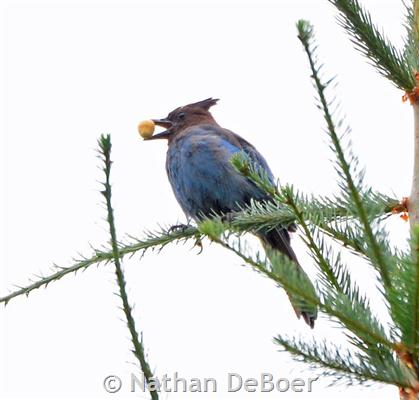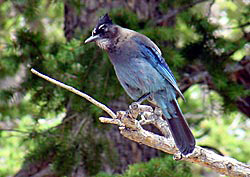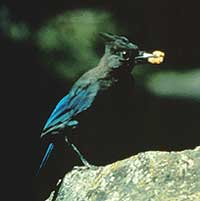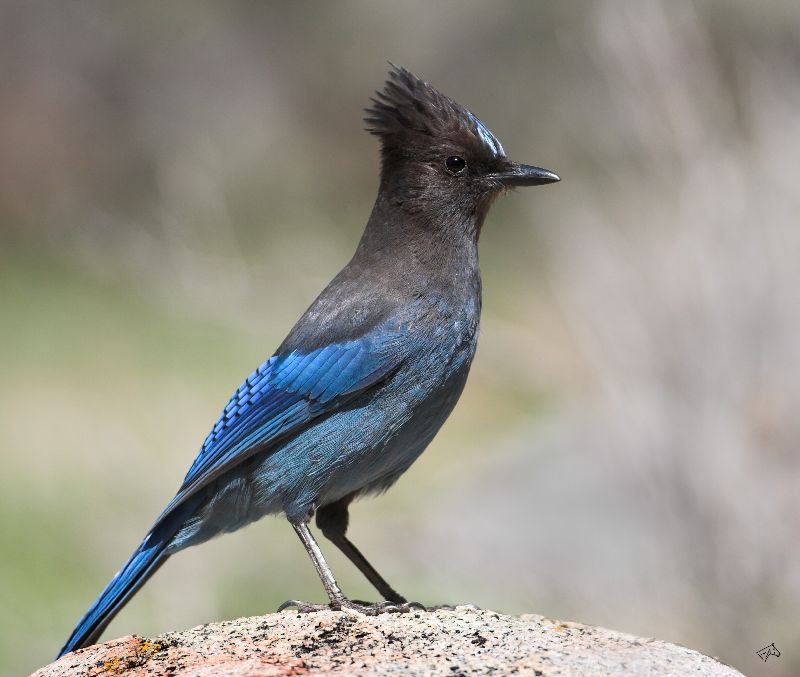Interactions
Feeding
Steller’s Jays are opportunistic feeders and also omnivores.
They primarily feed on nuts, berries, and seeds (AAB 2005).
Their food ranges anywhere from
peanuts to
chestnuts to
salmonberries. They forage the ground and eat whatever they find (AAB 2005).
Steller’s Jays also
scavenge when they are around humans.
They will eat anything from unprotected picnic items to garbage
left behind by campers (AAB 2005). This causes so me people
to think of Steller’s Jays as a nuisance because of their
presence at some campgrounds (ADW 2001). Steller’s Jays
are considered nest robbers. They are known to steal and
eat eggs of
other bird species. The usual victims are small
birds like the Pygmy Nuthatch and the Dark-eyed Junco. Sometimes they even eat the nestlings, baby birds
(AAB 2005). Steller’s Jays also eat small invertebrates,
like insects. Steller’s Jays prepare for winter
differently than birds generally do in the Midwest.
Steller’s Jays live in northwestern United States, and they just
stay in lower elevations during the winter (ADW 2001). To
prepare for winter, they store their nuts and seeds in caches,
which are collections of food in an inaccessible place to others. When they are collecting large nuts and seeds
for the winter, Steller’s Jays fit as many nuts as they can in
their mouth and throat and hide them one at a time. Steller’s Jays
are opportunistic birds, who are will to take hand-outs from people, as
well as steal the
caches of other birds (AAB
2005). An experiment ran in 1999 showed that Steller’s
Jays preferred to eat from feeders farther from cover, mainly
because it gave them more room to maneuver if facing a predator
(Bekoff et al. 1999). The experiment also revealed that
the jays were aggressive toward smaller animals, like chipmunks,
at the feeders, and tended to stay away from larger animals like
squirrels (Bekoff et al. 1999). These are some of the
feeding habits the Steller’s Jays tend to exhibit.
me people
to think of Steller’s Jays as a nuisance because of their
presence at some campgrounds (ADW 2001). Steller’s Jays
are considered nest robbers. They are known to steal and
eat eggs of
other bird species. The usual victims are small
birds like the Pygmy Nuthatch and the Dark-eyed Junco. Sometimes they even eat the nestlings, baby birds
(AAB 2005). Steller’s Jays also eat small invertebrates,
like insects. Steller’s Jays prepare for winter
differently than birds generally do in the Midwest.
Steller’s Jays live in northwestern United States, and they just
stay in lower elevations during the winter (ADW 2001). To
prepare for winter, they store their nuts and seeds in caches,
which are collections of food in an inaccessible place to others. When they are collecting large nuts and seeds
for the winter, Steller’s Jays fit as many nuts as they can in
their mouth and throat and hide them one at a time. Steller’s Jays
are opportunistic birds, who are will to take hand-outs from people, as
well as steal the
caches of other birds (AAB
2005). An experiment ran in 1999 showed that Steller’s
Jays preferred to eat from feeders farther from cover, mainly
because it gave them more room to maneuver if facing a predator
(Bekoff et al. 1999). The experiment also revealed that
the jays were aggressive toward smaller animals, like chipmunks,
at the feeders, and tended to stay away from larger animals like
squirrels (Bekoff et al. 1999). These are some of the
feeding habits the Steller’s Jays tend to exhibit.
Interacting with other Organisms
Steller’s Jays have some special behaviors when it comes to deterring
predators and interacting with each other. Steller’s Jays are
known to be social birds, and they can
mimic sounds anywhere from cats
and dogs to some mechanicals sounds. When they are in
flocks, they play by chasing each other around (AAB 2005). They
also exhibit agonistic behaviors, which is social behavior relating to
fighting. One of their forms of fighting is when two
birds fly upward and lock feet together and start pecking each other.
To establish social status
among the flock, they use crest displays (ADW 2001) and something called
aggressive sidling, which is  when two jays
size each other up to fight (Brown, 1963). When the two birds are
fighting, the one who opens up their wings is the inferior bird.
The opening of wings is seen as a sign of giving up to the dominant jay
in the flock (ADW 2001). Flocks of Steller’s Jays are territorial
and defend it by mobbing, which is when a flock of jays flying aggressively toward
a predatory bird (CAC 2013). Steller’s Jays’ impact on humans can
be both positive and negative. They eat a lot of insects, like
grasshoppers, which
can help with pest control, but their scavenging at campgrounds can make
them seem like a nuisance (ADW 2001). These are some of the more
noticeable behaviors displayed by the Steller’s Jay.
when two jays
size each other up to fight (Brown, 1963). When the two birds are
fighting, the one who opens up their wings is the inferior bird.
The opening of wings is seen as a sign of giving up to the dominant jay
in the flock (ADW 2001). Flocks of Steller’s Jays are territorial
and defend it by mobbing, which is when a flock of jays flying aggressively toward
a predatory bird (CAC 2013). Steller’s Jays’ impact on humans can
be both positive and negative. They eat a lot of insects, like
grasshoppers, which
can help with pest control, but their scavenging at campgrounds can make
them seem like a nuisance (ADW 2001). These are some of the more
noticeable behaviors displayed by the Steller’s Jay.
Back to Reproduction Forward to Facts
